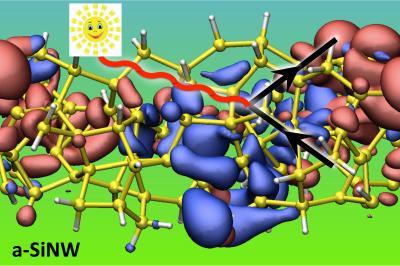Are you on Team Quantum Dots or Team Nanowires when the topic of future nanoscale energy-harvesting technology in solar panels comes up?
A trio of researchers used computational chemistry models to predict the electronic and optical properties of three types of nanoscale (billionth of a meter) silicon structures with a potential application for solar energy collection: a quantum dot, one-dimensional chains of quantum dots and a nanowire.
The ability to absorb light is substantially enhanced in nanomaterials compared to those used in conventional semiconductors. Determining which form -- quantum dots or nanowire -- maximizes this advantage was the goal of the numerical experiment conducted by the three researchers. The simulations indicated that light absorption by silicon quantum dot chains significantly increases with increased interactions between the individual nanospheres in the chain.

Amorphous Silicon nanowire (yellow network) facilitates harvesting of solar energy in the form of a photon (wavy line). In the process of light absorption a pair of mobile charge carriers is created (red clouds depict an electron smeared in space, while the blue clouds visualize the so-called hole which is a positively charged carrier). The energy of their directed motion is then transformed into electricity. Electron and hole charge distributions are often located in different regions of space due to multiple structural defects in amorphous silicon nanowires. Credit: A.Kryjevski, S.Kilina and D.Kilin/JRSE
"We used Density Functional Theory, a computational approach that allows us to predict electronic and optical properties that reflect how well the nanoparticles can absorb light, and how that effectiveness is affected by the interaction between quantum dots and the disorder in their structures," said Andrei Kryjevski from North Dakota State University. "This way, we can predict how quantum dots, quantum dot chains and nanowires will behave in real life even before they are synthesized and their working properties experimentally checked."
They also found that light absorption by quantum dot chains and nanowires depends strongly on how the structure is aligned in relation to the direction of the photons striking it. Finally, the researchers learned that the atomic structure disorder in the amorphous nanoparticles results in better light absorption at lower energies compared to crystalline-based nanomaterials.
"Based on our findings, we believe that putting the amorphous quantum dots in an array or merging them into a nanowire are the best assemblies for maximizing the efficiency of silicon nanomaterials to absorb light and transport charge throughout a photovoltaic system," Kryjevski said. "However, our study is only a first step in a comprehensive computational investigation of the properties of semiconductor quantum dot assemblies.
"The next steps are to build more realistic models, such as larger quantum dots with their surfaces covered by organic ligands and simulate the processes that occur in actual solar cells," he added.
Citation: Andrei Kryjevski, Dmitri Kilin, and Svetlana Kilina, 'Amorphous silicon nanomaterials: Quantum dots versus nanowires', J. Renewable Sustainable Energy 5, 043120 2013 DOI:10.1063/1.4817728




Comments